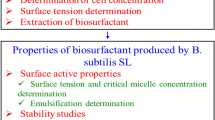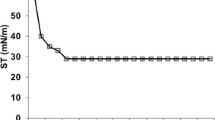Abstract
Bacillus sp. WD22, previously isolated from refinery effluent, degraded 71% of C8 hydrocarbons present in 1.0% v/v PCO in seawater (control medium), which reduced to 16.3%, on addition of yeast extract. The bacteria produced a biosurfactant in both media, whose surface was observed to be amorphous in nature under FESEM-EDAX analysis. The biosurfactant was characterized as a linear surfactin by LCMS and FT-IR analysis. The critical micelle concentration was observed as 50 mg/L and 60 mg/L at which the surface tension of water was reduced to 30 mN/m. Purified biosurfactant could emulsify petroleum-based oils and vegetable oils effectively and was stable at all tested conditions of pH, salinity and temperature up to 80 °C. The biosurfactant production was found to be mixed growth associated in control medium, while it was strictly growth associated in medium with yeast extract as studied by the Leudeking-Piret model.










Similar content being viewed by others
Data availability
The datasets generated during and/or analysed during the current study are available from the corresponding author on reasonable request.
References
Akbari S, Abdurahman NH, Yunus RM et al (2018) Biosurfactants—a new frontier for social and environmental safety: a mini review. Biotechnol Res Innov 2:81–90. https://doi.org/10.1016/j.biori.2018.09.001
Al-Hawash AB, Dragh MA, Li S et al (2018) Principles of microbial degradation of petroleum hydrocarbons in the environment. Egypt J Aquat Res 44:71–76
Asitok AG, Antai SP, Ekpenyong MG (2017) Water soluble fraction of crude oil uncouples protease biosynthesis and activity in hydrocarbonoclastic bacteria; implications for natural attenuation. Int J Sci 3:1–17. https://doi.org/10.18483/ijsci.1344
Atmayudha A, Syauqi A, Purwanto WW (2021) Green logistics of crude oil transportation: a multi-objective optimization approach. Clean Logist Supply Chain 1:100002. https://doi.org/10.1016/J.CLSCN.2021.100002
Barakat KM, Hassan SWM, Darwesh OM (2017) Biosurfactant production by haloalkaliphilic Bacillus strains isolated from Red Sea Egypt. Egypt J Aquat Res 43:205–211. https://doi.org/10.1016/j.ejar.2017.09.001
Chettri B, Singh AK (2019) Kinetics of hydrocarbon degradation by a newly isolated heavy metal tolerant bacterium Novosphingobium panipatense P5:ABC. Bioresour Technol 294:122190. https://doi.org/10.1016/j.biortech.2019.122190
Cruz JM, Hughes C, Quilty B et al (2018) Agricultural feedstock supplemented with manganese for biosurfactant production by Bacillus subtilis. Waste Biomass Valoriz 9:613–618. https://doi.org/10.1007/s12649-017-0019-6
da Silva RCSF, de Almeida DG, Brasileiro PPF et al (2019) Production, formulation and cost estimation of a commercial biosurfactant. Biodegradation 30:191–201. https://doi.org/10.1007/s10532-018-9830-4
Das AJ, Kumar R (2019) Production of biosurfactant from agro-industrial waste by Bacillus safensis J2 and exploring its oil recovery efficiency and role in restoration of diesel contaminated soil. Environ Technol Innov 16:100450. https://doi.org/10.1016/J.ETI.2019.100450
Datta P, Tiwari P, Pandey LM (2018) Isolation and characterization of biosurfactant producing and oil degrading Bacillus subtilis MG495086 from formation water of Assam oil reservoir and its suitability for enhanced oil recovery. Bioresour Technol 270:439–448. https://doi.org/10.1016/j.biortech.2018.09.047
Goveas LC, Krishna A, Salian A et al (2020) Isolation and characterization of bacteria from refinery effluent for degradation of petroleum crude oil in seawater. J Pure Appl Microbiol 14:473–484. https://doi.org/10.22207/JPAM.14.1.49
Goveas LC, Sajankila SP (2020) Effect of yeast extract supplementation on halotolerant biosurfactant production kinetics coupled with degradation of petroleum crude oil by Acinetobacter baumannii OCB1 in marine environment. Bioresour Technol Rep 11:100447. https://doi.org/10.1016/j.biteb.2020.100447
Han Y, Nambi IM, Clement TP (2018) Environmental impacts of the Chennai oil spill accident – a case study. Sci Total Environ 626:795–806. https://doi.org/10.1016/j.scitotenv.2018.01.128
Hentati D, Chebbi A, Hadrich F et al (2019) Production, characterization and biotechnological potential of lipopeptide biosurfactants from a novel marine Bacillus stratosphericus strain FLU5. Ecotoxicol Environ Saf 167:441–449. https://doi.org/10.1016/J.ECOENV.2018.10.036
Heryani H, Putra MD (2017) Kinetic study and modeling of biosurfactant production using Bacillus sp. Electron J Biotechnol 27:49–54. https://doi.org/10.1016/j.ejbt.2017.03.005
Karlapudi AP, Venkateswarulu TC, Tammineedi J et al (2018) Role of biosurfactants in bioremediation of oil pollution-a review. Petroleum 4:241–249. https://doi.org/10.1016/j.petlm.2018.03.007
Kezrane I, Harouna BM, Hamadache M et al (2020) Use of hydrocarbons sludge as a substrate for the production of biosurfactants by Pseudomonas aeruginosa ATCC 27853. Environ Monit Assess 192:1–16. https://doi.org/10.1007/s10661-020-08269-3
Lowry OH, Rosebrough NJ, Farr AL, Randall RJ (1951) Protein measurement with the Folin phenol reagent. J Biol Chem 193:265–275
Lyu Y, Zhang T, Dou B et al (2018) A lipopeptide biosurfactant from Bacillus sp. Lv13 and their combined effects on biodesulfurization of dibenzothiophene. RSC Adv 8:38787–38791. https://doi.org/10.1039/c8ra06693k
Marathe SK, Vashistht MA, Prashanth A et al (2018) Isolation, partial purification, biochemical characterization and detergent compatibility of alkaline protease produced by Bacillus subtilis, Alcaligenes faecalis and Pseudomonas aeruginosa obtained from sea water samples. J Genet Eng Biotechnol 16:39–46. https://doi.org/10.1016/j.jgeb.2017.10.001
Medić A, Lješević M, Inui H et al (2020) Efficient biodegradation of petroleum: N-alkanes and polycyclic aromatic hydrocarbons by polyextremophilic Pseudomonas aeruginosa san ai with multidegradative capacity. RSC Adv 10:14060–14070. https://doi.org/10.1039/c9ra10371f
Nouni MR, Jha P, Sarkhel R et al (2021) Alternative fuels for decarbonisation of road transport sector in India: options, present status, opportunities, and challenges. Fuel 305:121583. https://doi.org/10.1016/J.FUEL.2021.121583
Rao P, Pattabiraman TN (1989) Reevaluation of the phenol-sulfuric acid reaction for the estimation of hexoses and pentoses. Anal Biochem 181:18–22. https://doi.org/10.1016/0003-2697(89)90387-4
Sana S, Mazumder A, Datta S, Biswas D (2017) Towards the development of an effective in vivo wound healing agent from Bacillus sp. derived biosurfactant using Catla catla fish fat. RSC Adv 7:13668–13677. https://doi.org/10.1039/c6ra26904d
Satpute SK, Banpurkar AG, Dhakephalkar PK et al (2010) Methods for investigating biosurfactants and bioemulsifiers: a review. Crit Rev Biotechnol 30:127–144. https://doi.org/10.3109/07388550903427280
Singh AK, Sharma P (2020) Disinfectant-like activity of lipopeptide biosurfactant produced by Bacillus tequilensis strain SDS21. Colloids Surf B Biointerfaces 185:110514. https://doi.org/10.1016/J.COLSURFB.2019.110514
Ukhurebor KE, Athar H, Adetunji CO et al (2021) Environmental implications of petroleum spillages in the Niger Delta region of Nigeria: a review. J Environ Manage 293:112872. https://doi.org/10.1016/J.JENVMAN.2021.112872
Vandana, Priyadarshanee M, Mahto U, Das S (2022) Mechanism of toxicity and adverse health effects of environmental pollutants. In: Microb Biodegrad Bioremediation. pp 33–53. https://doi.org/10.1016/B978-0-323-85455-9.00024-2
Velázquez-Aradillas JC, Toribio-Jiménez J, del Carmen Ángeles González-Chávez M et al (2011) Characterisation of a biosurfactant produced by a Bacillus cereus strain tolerant to cadmium and isolated from green coffee grain. World J Microbiol Biotechnol 27:907–913.https://doi.org/10.1007/S11274-010-0533-1/FIGURES/6
Wu HC, Dissard D, Douville E et al (2018) (2018) Surface ocean pH variations since 1689 CE and recent ocean acidification in the tropical South Pacific. Nat Commun 91(9):1–13. https://doi.org/10.1038/s41467-018-04922-1
Yaraguppi DA, Bagewadi ZK, Muddapur UM, Mulla SI (2020) Response surface methodology-based optimization of biosurfactant production from isolated Bacillus aryabhattai strain ZDY2. J Pet Explor Prod Technol 10:2483–2498. https://doi.org/10.1007/s13202-020-00866-9
Datta P, Tiwari P, Pandey LM (2020) Oil washing proficiency of biosurfactant produced by isolated Bacillus tequilensis MK 729017 from Assam reservoir soil. J Pet Sci Eng 195:107612. https://doi.org/10.1016/j.petrol.2020.107612
Goveas LC, Selvaraj R, Vinayagam R, Alsaiari AA, Alharthi NS, Sajankila SP (2022) Nitrogen dependence of rhamnolipid mediated degradation of petroleum crude oil by indigenous Pseudomonas sp. WD23 in seawater. Chemosphere 304:135235. https://doi.org/10.1016/j.chemosphere.2022.135235
Das AJ, Kumar R (2019) Production of biosurfactant from agro-industrial waste by Bacillus safensis J2 and exploring its oil recovery efficiency and role in restoration of diesel contaminated soil. Environ Technol Innov 16:100450. https://doi.org/10.1016/j.eti.2019.100450
Liu Q, Niu J, Yu Y, Wang C, Lu S, Zhang S, Lv J, Peng B (2021) Production, characterization and application of biosurfactant produced by Bacillus licheniformis L20 for microbial enhanced oil recovery. J Clean Prod 307:127193. https://doi.org/10.1016/j.jclepro.2021.127193
Acknowledgements
LCG thanks the Vision Group of Science and Technology, Govt. of Karnataka (VGST-GoK) for funding this research work under RGS-F grant (GRD No 846/315).
Funding
This work is funded by the Vision Group of Science and Technology, Govt. of Karnataka (VGST-GoK) RGS-F grant (GRD No 846/315).
Author information
Authors and Affiliations
Contributions
Louella Concepta Goveas: Conceptualization, methodology, validation, investigation, writing—original draft, writing—review and editing. Shyama Prasad Sajankila: Methodology, supervision. Raja Selvaraj: Validation, supervision.
Corresponding author
Ethics declarations
Ethics approval
Not applicable.
Consent to participate
Not applicable.
Consent for publication
Not applicable.
Conflict of interest
The authors declare no competing interests.
Additional information
Responsible Editor: Luiz Henrique Rosa
Publisher's note
Springer Nature remains neutral with regard to jurisdictional claims in published maps and institutional affiliations.
Supplementary information
Below is the link to the electronic supplementary material.
Rights and permissions
Springer Nature or its licensor holds exclusive rights to this article under a publishing agreement with the author(s) or other rightsholder(s); author self-archiving of the accepted manuscript version of this article is solely governed by the terms of such publishing agreement and applicable law.
About this article
Cite this article
Goveas, L.C., Selvaraj, R. & Sajankila, S.P. Characterization of biosurfactant produced in response to petroleum crude oil stress by Bacillus sp. WD22 in marine environment. Braz J Microbiol 53, 2015–2025 (2022). https://doi.org/10.1007/s42770-022-00811-4
Received:
Accepted:
Published:
Issue Date:
DOI: https://doi.org/10.1007/s42770-022-00811-4




